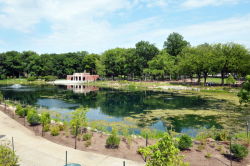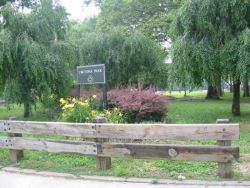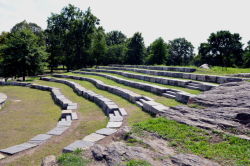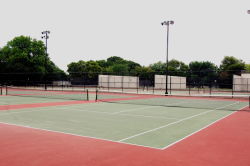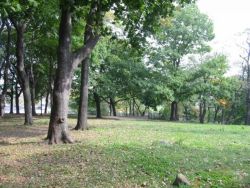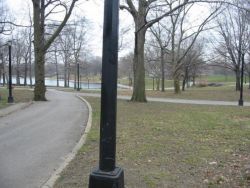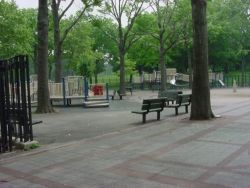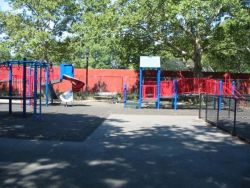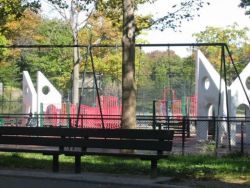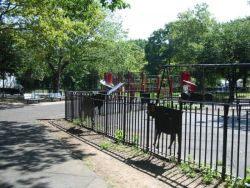Crotona Park
Playground of the Stars
This playground takes its name from the four constellations engraved in the pavement near the site’s spray fountain. The constellations are Cetus (The Sea Monster), Cygnus (The Swan), Ursa Major (The Great Bear), and Canis Major (The Big Dog).
In the Greek myth surrounding Cetus, King Cepheus and Queen Cassiopeia of Æthiopia bore a child, Andromeda. Queen Cassiopeia boasted that her own beauty, as well as that of her daughter, exceeded the beauty of the sea goddess Nereids. Upon hearing this, Nereids grew angry and asked Poseidon (the Greek god of the waters, earthquakes, and horses) to punish the queen. Poseidon then commanded the sea-monster Cetus to destroy King Cepheus’s land.
As Cetus began his destruction, the people approached King Cepheus and begged him for help. Cepheus went to an oracle, who told him that the only way to stop Cetus was to sacrifice Andromeda. Cepheus agreed, and ordered his daughter chained to a rock over looking the sea. Cetus began to swim toward the girl, but just then Perseus, the son of Zeus and Danae, was returning from having slain Medusa, the most famous of the three Gorgons, when he caught sight of Andromeda chained to the rock. Perseus told the king that he would kill Cetus in exchange for the kingdom and Andromeda’s hand in marriage. Cepheus agreed, and Perseus slew Cetus. The constellation Cetus is located in the equatorial region of the Southern Hemisphere near Aquarius and Eridanus.
There are different myths surrounding the constellation of Cygnus. One story is that Cygnus was a friend to Phaethon, the son of Helios the Sun-god, who died while trying to ride his father’s chariot. Apollo (the Greek god of the sun, prophecy, music, medicine, and poetry) upon seeing Cygnus’s grief over Phaethon’s death, took mercy on him by turning him into a swan and setting him in the heavens. The constellation Cygnus is in the Northern Hemisphere near Lacerta and Lyra.
The myth of Callisto explains the presence of Ursa Major in the night sky. Callisto was a woman who preferred to hunt rather than partake in the traditional female duties. Zeus took the form of Artemis, the goddess of the hunt, and approached Callisto. Callisto was excited, believing that Zeus was her mistress, and spoke openly of her hunting trips. Zeus seduced Callisto, who later gave birth to a son, Arcas. Hera, Zeus’s wife, became angered and turned Callisto into a bear. One day while he was hunting, Arcas came upon his mother in the form of a bear. However, before Arcas could kill what he believed to simply be a bear, Zeus intervened by turning Arcas into a bear as well, and sent both he and his mother into the heavens.
Canis Major is located in the Southern Hemisphere near the Orion constellation. Orion was half god, half human, born of Poseidon and of a mortal woman. Artemis, the goddess of the hunt, fell in love with Orion, but she was a virgin and was required to remain chaste. If she made love to Orion she would sacrifice her powers as a goddess. Her twin brother Apollo (the Greek god of the sun) determined to protect his sister’s chastity, sent a scorpion to attack Orion. Artemis was crushed when she discovered that her love was dead and placed Orion in the heavens near his two dogs, Canis Major (“The Larger Dog”), and Canis Minor (“The Smaller Dog”).
The City of New York acquired the property that is now Crotona Park from the Bathgate family in the 1880’s. The Bathgates were a farming family who worked the lands of Morris Manor in the mid-1800s before establishing their own 140-acre farm in Morrisania, the present site of Crotona Park. Playground of the Stars is situated in the southwest corner of Crotona Park. It features a spray shower with a decorative red spaceship cutout mounted on a large blue cylinder. A gray circular stone area surrounds the shower with four constellations named by both their Latin and English names.
The park features a flagpole with a yardarm, and three blue and yellow pieces of play equipment, all with safety surfacing. The surrounding pavement is also decorated with star-patterns. On March 31, 1999 Parks completed a $600,000 renovation of the site funded by Council Member Jose Rivera. The playground has planting areas, brick paths, game tables with benches, and a red park house.
Check out your park's Vital Signs
Clean & Safe
Green & Resilient
Empowered & Engaged Users
Share your feedback or learn more about how this park is part of a
Vital Park System

